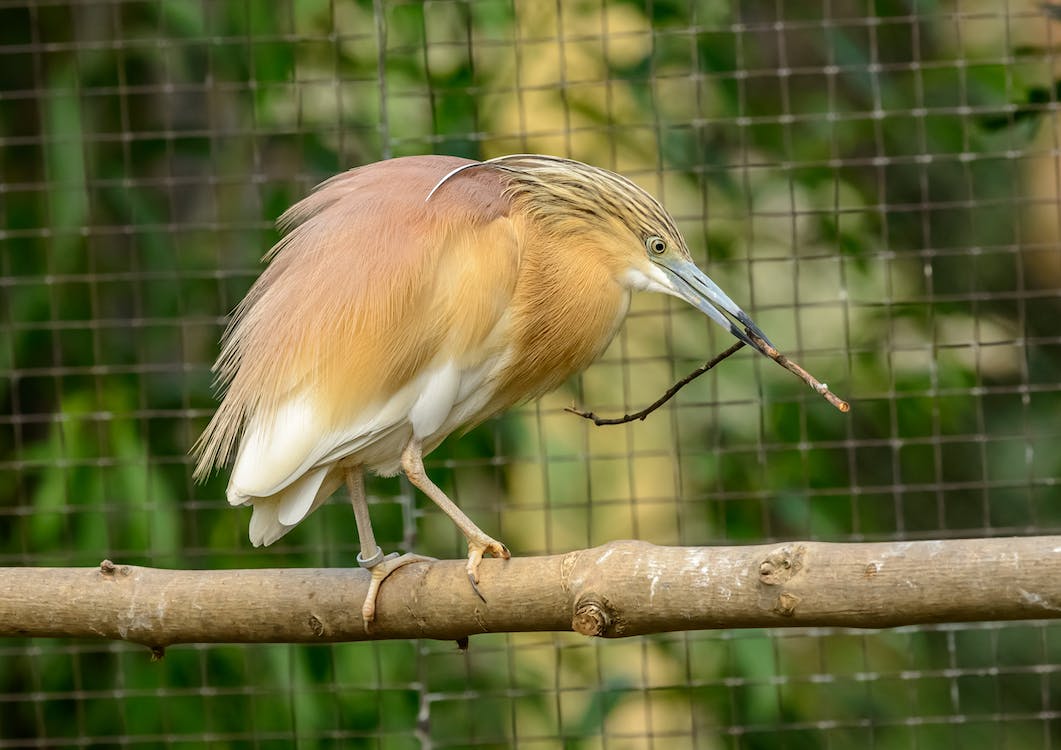It is a bird that migrates from Europe to Africa during the winter, thriving in marshes, ponds, lakes, with reed beds and other vegetations. This bird pursues its prey quite sluggishly, crouching quietly at water edges. It is buffy brown at rest but becomes mostly white when in flight as its white wings and tail opens up for sight.
Read further to know more about the Squacco Heron.
What is a Squacco Heron?
Squacco heron (Ardeola ralloides) is an elegant little hero with Old World origins, which breeds in the Greater Middle East and southern Europe. This bird feeds on small aquatic creatures, which it catches using its bill, after long minutes of waiting and hunching. It nests in thick reeds or dense willows, typically in a loosely-structured colony, with other heron cousins and even egrets.
Its seven levels of classification are as follows:
Kingdom: Animalia
Phylum: Chordata
Class: Aves
Order: Pelecaniformes
Family: Ardeidae
Genus: Ardeola
Species: A. ralloides
Squacco Heron Physical Description
Squacco herons are small herons, growing 17 to 19 inches long or 44-47 centimeters, and have a wingspan of 31 to 36 inches or 80-92 centimeters. It has two distinct looks, breeding and non-breeding plumage.
When these birds are in their non-breeding plumage, squacco herons are dull brown and dark and light-streaked. During rest, they have white underparts and yellowish-brown upperparts. When in flight, their white wings and tails stand out. Meanwhile, shoulders, nape, and head are also black-streaked. Their bill is blackish on top with a yellow on the lower mandible. Eyes are also yellow, accentuated by a thin red eyering and greenish-yellow lores. Non-breeding squacco heron’s feet and legs are also of a greenish-yellow tone.
During breeding, their feathers become very long. The body is whitish with cinnamon nape, breast side, and back. Their underparts are also cinnamon though relatively lighter, especially on their chest. Tail, wings, throat, chin are all white. The neck and side of the head are also cinnamon. During the breeding season, adult squacco herons develop an erectile crest with long, fuzzy black and white feathers. Their bill turns into a vibrant blue color with a black tip. Eyes remain yellow, but lores become greenish-blue. Feet and legs tend to have a striking orange-yellow to a reddish shade.
Where can they be spotted?
Squacco Herons thrive in various freshwater wetland habitats, such as flooded areas, swamps, deltas, river valleys, ponds, lakes, ricefields, ditches, or other locations brimming with vegetation. These birds rarely occur in coastal habitats, estuaries, and islets though, there are instances when they can be observed along coasts, specifically in Senegal.
Squacco Herons occur in southwestern and central Europe, southeast Iran, Madagascar, and north and south of the Sahara in Africa.
Interesting Facts You Should Know About the Squacco Heron
Squacco Herons’ diet revolves primarily on small prey such as grasshoppers, spiders, butterflies, beetles, insect larvae, mollusks, crustaceans, amphibians, fish, and occasionally small birds. Like their cousins from the Ardeidae family, they stand motionless and quiet in vegetation, waiting for their victims. They may hunch while feeding and may use insects as baits. These birds may feed in small groups but with ample distance from each other. Often, their head and neck are only visible when hunting.
During the breeding season, these typically solitary birds breed in small groups to colonies. As part of their courtship rituals, both sexes acquire more vibrant colors on their bodies’ bare parts and develop longer back feathers and crest. Courtship antics usually occur in the nest or nearby it.
Squacco herons establish large colonies in reedbeds, trees, dense willows, often with other species from the Ardeidae family. They create their relatively low, usually less than two meters from the grounds but may also occur in trees up to 20 meters high, 5-10 meters away from other nests. Materials used for the nests are sticks and twigs.
In Europe, squacco herons lay a clutch of 4 to 7 eggs, while populations in Africa lay 2 to 3. Parents will jointly incubate the eggs for around 22-24 days. After hatching, chicks are grayish-brown, with white down feathers. Both sexes will feed and tend to the broods. Two weeks later, chicks can leave and the nest and start to perch nearby. They will stay under parental care for another 45 days before dispersing.
Squacco herons are spread throughout, and their species is not globally threatened. However, their population experiences some decline in Europe due to the loss of wetlands habitats. Also, they are often hunted in Nigeria for traditional medicine. They are listed as least concern species in the IUCN Red List.
WILDLIFE PARKS AND RESERVES WHERE THIS SPECIES IS FOUND:
SOUTH AFRICA
Kalahari Gemsbok National Park
NAMIBIA
ZAMBIA
ZIMBABWE
BOTSWANA
BOTSWANA BIRDS | SOUTH AFRICA BIRDS
NAMIBIA BIRDS | ZAMBIA BIRDS | ZIMBABWE BIRDS

